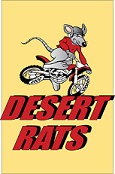Local History Notes


The places Desert Rats often camp and ride are flush with fascinating historical features. Here is a little background about some of them,
The Water Tower at Searles Station is pretty much all that's left of Garden City Station. Garden City Station started out as a way-station for the famous 20 Mule Teams hauling borax out of Trona where tired teams were switched out and driver's took a well-deserved break. Later, then the railroad took over it became a rail switching center. Eventually it was abandoned. All that remains is the railroad water tower and some remnants of a windmill and the dikes that held the water. There is still an active railroad switching yard on the south side of Searles Station Road where railroad cars to and from Trona are transferred to the Union Pacific.
Another place of interest is the X-15 crash site. Major Mike Adams became the first astronaut to die in the crash of an X-15 in the Mojave Desert not far from Searles Stations on November 15, 1967. He gets credit for being an astronaut because he flew the X-15 high enough to qualify for having gone into space. A memorial was created at the crash site by Eagle Scout John Bodylski. All the X-15 wreckage has been long since removed, but the memorial marks the spot and gives a little information about the crash. To find the memorial from US395, turn north on Trona Road between Red Mountain and Johannesburg. It's almost exactly 4 miles from US395 to the access road; look for a dirt driveway on the west side of the road. The memorial is only about 1/4 mile west of Trona Road, so it would be possible to park on the shoulder and walk in. At the site there is an X-shaped concrete pad with a monument and several educational panels about Major Adams and the X-15 program. The road can be negotiated in a regular passenger car in dry weather but you will probably need an OHV or 4x4 to reach it after a rain or snow.
Of course the little town of Randsburg is itself a historical site. It boasts a saloon and general store along with some antique shops. There is designated OHV parking near the saloon, courtesy of the saloon and off-road organizations. The general store even stocks a few OHV related parts and gear. There is a small pavilion with restrooms about in the middle of town, provided by the local merchants for OHV rider's convenience.
Red Mountain was originally called Osdick after P.J. Osdick the owner of several local claims. It was founded in 1919 and was renamed Red Mountain in 1929.
Johannesburg was founded to support mining operations at Randsburg. In addition to providing rail access, the region's first wells were operated by companies located in Johannesburg. Johannesburg was named by miners who had previously worked in the gold-producing region of South Africa. The town is frequently referred to as "Jo-burg" by locals and frequent visitors to the northwest Mojave.